Gelöste Aufgaben/Kw99: Unterschied zwischen den Versionen
Keine Bearbeitungszusammenfassung |
Keine Bearbeitungszusammenfassung |
||
| (10 dazwischenliegende Versionen desselben Benutzers werden nicht angezeigt) | |||
| Zeile 12: | Zeile 12: | ||
<onlyinclude> | <onlyinclude> | ||
[[Datei:Kw98-01.png|alternativtext=|links|mini|250x250px|Lageplan]] | [[Datei:Kw98-01.png|alternativtext=|links|mini|250x250px|Lageplan]] | ||
Gesucht ist die analytische Lösung für den Euler-Bernoulli-Balken. | Gesucht ist die analytische Lösung für den Euler-Bernoulli-Balken. Im Vergleich zu [[Gelöste Aufgaben/Kw98|Kw98]] wird hier eine Lösung mit normierten Koordinaten verfolgt. | ||
</onlyinclude> | </onlyinclude> | ||
Ermitteln Sie für ein Euler-Bernoulli-Modell die analytischen Verläufe der Schnittgrößen und Verschiebungen im Balken für diese Parameter: | Ermitteln Sie für ein Euler-Bernoulli-Modell die analytischen Verläufe der Schnittgrößen und Verschiebungen im Balken für diese Parameter: | ||
::<math>\begin{array}{ll}\displaystyle {{\mathit{EI}}_{2}}&=\frac{{{\mathit{EI}}_{1}}}{2},\\ {{K}_{A}}&=\displaystyle \frac{{{\mathit{EI}}_{1}}}{{{\ell}_{1}}},\\ {{k}_{B}}&=0,\\ {{k}_{C}}&=\displaystyle \frac{{{\mathit{EI}}_{1}}}{{{\ell}_{1}^{3}}},\\ {{q}_{B}}&=4\cdot {{q}_{A}},\\ {{\ell}_{2}}&=\displaystyle \frac{{{\ell}_{1}}}{2},\\ {{M}_{B}}&=5\cdot {{\ell}_{1}^{2}}\cdot {{q}_{A}}\end{array}</math>. | |||
== Lösung mit Maxima == | == Lösung mit Maxima == | ||
| Zeile 35: | Zeile 35: | ||
{{MyCodeBlock|title=Header | {{MyCodeBlock|title=Header | ||
|text= | |text= | ||
Diese Aufgabe mit der [[Randwertprobleme/Methoden zur Lösung von Randwertproblemen/Finite Elemente Methode|Methode der Finiten Elemente]] in [[Gelöste Aufgaben/Kw96|KW96]] gelöst. | Diese Aufgabe wird mit der [[Randwertprobleme/Methoden zur Lösung von Randwertproblemen/Finite Elemente Methode|Methode der Finiten Elemente]] in [[Gelöste Aufgaben/Kw96|KW96]] gelöst. Und im Vergleich zu [[Gelöste Aufgaben/Kw98|KW98]] wird hier die analytische Lösung mit dimensionslosen Koordinaten angeschreiben. | ||
|code= | |code= | ||
<syntaxhighlight lang="lisp" line start=1> | <syntaxhighlight lang="lisp" line start=1> | ||
| Zeile 43: | Zeile 43: | ||
/* author: Andreas Baumgart */ | /* author: Andreas Baumgart */ | ||
/* last updated: 2017-09-06 */ | /* last updated: 2017-09-06 */ | ||
/* ref: TM-C, Labor 1 | /* ref: TM-C, Labor 1 - dimensionslos */ | ||
/* description | /* description: die Auslenkung w und die unabhängige */ | ||
/* | /* Ortskoordinate werden dim'los gemacht */ | ||
/*******************************************************/ | /*******************************************************/ | ||
</syntaxhighlight> | </syntaxhighlight> | ||
| Zeile 53: | Zeile 53: | ||
{{MyCodeBlock|title=Declarations | {{MyCodeBlock|title=Declarations | ||
|text= | |text= | ||
Wir definieren | Wir definieren die Formfunktionen für die Streckenlast | ||
::<math>\begin{array}{l}{{\phi}_{0}}\left( \xi\right) :=1-\xi\\{{\phi}_{1}}\left( \xi\right) :=\xi\end{array} \text{ mit } \xi = \displaystyle\frac{x_1}{\ell_1}</math>. | |||
::<math>\begin{array}{l}{{\phi}_{0}}\left( \xi\right) :=1-\xi\\{{\phi}_{1}}\left( \xi\right) :=\xi\end{array}</math>. | |||
|code= | |code= | ||
<syntaxhighlight lang="lisp" line start=1> | <syntaxhighlight lang="lisp" line start=1> | ||
/* system parameter */ | /* system parameter */ | ||
params: [EI[2]=EI[1]/2, | |||
params : [ | K[A]=EI[1]/l[1], | ||
k[B]=0, | |||
k[C] = EI[1]/l[1]^3, | |||
q[B]=4*q[A], | |||
l[2]=l[1]/2, | |||
M[B] = 5*q[A]*l[1]^2]; | |||
/* form - functions */ | /* form - functions */ | ||
| Zeile 77: | Zeile 71: | ||
</syntaxhighlight> | </syntaxhighlight> | ||
}} | }} | ||
<!--------------------------------------------------------------------------------> | <!--------------------------------------------------------------------------------> | ||
{{MyCodeBlock|title= | {{MyCodeBlock|title=Integration of Differential Equation to Formfunction | ||
|text= | |text= | ||
In Bereich I und II gilt dieselbe Bewegungs-Differentialgleichung | In Bereich I und II gilt dieselbe Bewegungs-Differentialgleichung | ||
| Zeile 85: | Zeile 80: | ||
::<math>E\; I_i w_i^{IV}(x_i) = q(x_i) ,\;\; i=\{1,2\} \text{ mit } q(x_i) = q_0\cdot\phi_0(\xi) + q_1\cdot\phi_1(\xi)</math>, | ::<math>E\; I_i w_i^{IV}(x_i) = q(x_i) ,\;\; i=\{1,2\} \text{ mit } q(x_i) = q_0\cdot\phi_0(\xi) + q_1\cdot\phi_1(\xi)</math>, | ||
die wir durch Integration lösen und dann bereichsweise anpassen. | die wir durch Integration lösen und dann bereichsweise an Rand- und Übergangsbedingungen anpassen. Diese Aufgabe wird etwas übersichtlicher, wenn wir die Auslenkung ''w'' und die Ortskoordinate ''x'' dimensionslos machen. So wählen wir: | ||
::<math>w = \ell_{Bez}\cdot \tilde{w}</math> | |||
und setzten für die Bezugslänge die Auslenkung eines Kragbalkens unter konstanter Streckenlast (hier ''q<sub>A</sub>'') an. Diese Auslenkung findet man in [[Sources/Lexikon/Standard-Lösungen|Standard-Lösungen]] unter "Kragbalken mit Streckenlast" zu: | |||
::<math>{{\ell}_{\mathit{Bez}}}=\displaystyle \frac{{{q}_{A}} \cdot {{\ell}_{1}^{4}}}{8\cdot {{\mathit{EI}}_{1}}}</math> | |||
Zusätzlich wählen wir zwei unabhängige, dimensionslose Ortskoordinaten für die Bereich I und II, die ihren Ursprung jeweils in den Punkten A und B haben. | |||
::<math>\xi_i = \displaystyle \frac{x_i}{\ell_i}</math> | |||
Mit | |||
::<math>\begin{array}{lll}q_0=q_A, &q_1=q_B &\text{ für Bereich I und}\\q_0=0, &q_1=0 &\text{ für Bereich II}\end{array}</math> | |||
::<math>\displaystyle \phi_i(x) = \frac{ | ist die allgemeine Lösung für | ||
::<math>\begin{array}{ll} \ldots\text{ die Verdrehung: }&\displaystyle \phi_i(x) = \frac{d\,w_i(x)}{d\,x_i}\\ \ldots\text{ das Biege-Moment: }&\displaystyle M_i(x) = - EI_i \frac{d^2\,w_i(x)}{d\,x_i^2}\\ \ldots\text{ die Querkraft: }&\displaystyle Q_i(x) = - EI_i \frac{d^3\,w_i(x)}{d\,x_i^3} \end{array}</math> | |||
... für Bereich I: | ... für Bereich I: | ||
::<math>\begin{array}{ | ::<math>\begin{array}{ll} {{w}_{1}}\left( \xi\right) :=&\frac{120\cdot {{C}_{1,0}}\cdot {{\ell}_{\mathit{Bez}}}+120\cdot {{C}_{1,1}}\cdot {{\ell}_{\mathit{Bez}}}\cdot \xi+60\cdot {{C}_{1,2}}\cdot {{\ell}_{\mathit{Bez}}}\cdot {{\xi}^{2}}+20\cdot {{C}_{1,3}}\cdot {{\ell}_{\mathit{Bez}}}\cdot {{\xi}^{3}}+\left( 5\cdot {{\ell}_{\mathit{Bez}}}\cdot {{\xi}^{4}}-{{\ell}_{\mathit{Bez}}}\cdot {{\xi}^{5}}\right) \cdot {{q}_{A}}+{{\ell}_{\mathit{Bez}}}\cdot {{\xi}^{5}}\cdot {{q}_{B}}}{15\cdot {{q}_{A}}}\\ {{\phi}_{1}}\left( \xi\right) :=&\frac{120\cdot {{C}_{1,1}}\cdot {{\ell}_{\mathit{Bez}}}+120\cdot {{C}_{1,2}}\cdot {{\ell}_{\mathit{Bez}}}\cdot \xi+60\cdot {{C}_{1,3}}\cdot {{\ell}_{\mathit{Bez}}}\cdot {{\xi}^{2}}+\left( 20\cdot {{\ell}_{\mathit{Bez}}}\cdot {{\xi}^{3}}-5\cdot {{\ell}_{\mathit{Bez}}}\cdot {{\xi}^{4}}\right) \cdot {{q}_{A}}+5\cdot {{\ell}_{\mathit{Bez}}}\cdot {{\xi}^{4}}\cdot {{q}_{B}}}{15\cdot {{\ell}_{1}}\cdot {{q}_{A}}}\\ {{M}_{1}}\left( \xi\right) :=&-\frac{{{\mathit{EI}}_{1}}\cdot \left( 120\cdot {{C}_{1,2}}\cdot {{\ell}_{\mathit{Bez}}}+120\cdot {{C}_{1,3}}\cdot {{\ell}_{\mathit{Bez}}}\cdot \xi+\left( 60\cdot {{\ell}_{\mathit{Bez}}}\cdot {{\xi}^{2}}-20\cdot {{\ell}_{\mathit{Bez}}}\cdot {{\xi}^{3}}\right) \cdot {{q}_{A}}+20\cdot {{\ell}_{\mathit{Bez}}}\cdot {{\xi}^{3}}\cdot {{q}_{B}}\right) }{15\cdot {{\ell}_{1}^{2}}\cdot {{q}_{A}}}\\ {{Q}_{1}}\left( \xi\right) :=&-\frac{{{\mathit{EI}}_{1}}\cdot \left( 120\cdot {{C}_{1,3}}\cdot {{\ell}_{\mathit{Bez}}}+\left( 120\cdot {{\ell}_{\mathit{Bez}}}\cdot \xi-60\cdot {{\ell}_{\mathit{Bez}}}\cdot {{\xi}^{2}}\right) \cdot {{q}_{A}}+60\cdot {{\ell}_{\mathit{Bez}}}\cdot {{\xi}^{2}}\cdot {{q}_{B}}\right) }{15\cdot {{\ell}_{1}^{3}}\cdot {{q}_{A}}} \end{array}</math> | ||
... für Bereich II: | ... für Bereich II: | ||
::<math>\begin{array}{ | ::<math>\begin{array}{ll} {{w}_{2}}\left( \xi\right) :=&\frac{24\cdot {{\mathit{EI}}_{1}}\cdot {{\ell}_{2}^{4}}\cdot {{C}_{2,0}}\cdot {{\ell}_{\mathit{Bez}}}+24\cdot {{\mathit{EI}}_{1}}\cdot {{\ell}_{2}^{4}}\cdot {{C}_{2,1}}\cdot {{\ell}_{\mathit{Bez}}}\cdot \xi+12\cdot {{\mathit{EI}}_{1}}\cdot {{\ell}_{2}^{4}}\cdot {{C}_{2,2}}\cdot {{\ell}_{\mathit{Bez}}}\cdot {{\xi}^{2}}+4\cdot {{\mathit{EI}}_{1}}\cdot {{\ell}_{2}^{4}}\cdot {{C}_{2,3}}\cdot {{\ell}_{\mathit{Bez}}}\cdot {{\xi}^{3}}}{3\cdot {{\ell}_{1}^{4}}\cdot {{\mathit{EI}}_{2}}\cdot {{q}_{A}}}\\ {{\phi}_{2}}\left( \xi\right) :=&\frac{24\cdot {{\mathit{EI}}_{1}}\cdot {{\ell}_{2}^{4}}\cdot {{C}_{2,1}}\cdot {{\ell}_{\mathit{Bez}}}+24\cdot {{\mathit{EI}}_{1}}\cdot {{\ell}_{2}^{4}}\cdot {{C}_{2,2}}\cdot {{\ell}_{\mathit{Bez}}}\cdot \xi+12\cdot {{\mathit{EI}}_{1}}\cdot {{\ell}_{2}^{4}}\cdot {{C}_{2,3}}\cdot {{\ell}_{\mathit{Bez}}}\cdot {{\xi}^{2}}}{3\cdot {{\ell}_{1}^{4}}\cdot {{\ell}_{2}}\cdot {{\mathit{EI}}_{2}}\cdot {{q}_{A}}}\\ {{M}_{2}}\left( \xi\right) :=&-\frac{24\cdot {{\mathit{EI}}_{1}}\cdot {{\ell}_{2}^{4}}\cdot {{C}_{2,2}}\cdot {{\ell}_{\mathit{Bez}}}+24\cdot {{\mathit{EI}}_{1}}\cdot {{\ell}_{2}^{4}}\cdot {{C}_{2,3}}\cdot {{\ell}_{\mathit{Bez}}}\cdot \xi}{3\cdot {{\ell}_{1}^{4}}\cdot {{\ell}_{2}^{2}}\cdot {{q}_{A}}}\\ {{Q}_{2}}\left( \xi\right) :=&-\frac{8\cdot {{\mathit{EI}}_{1}}\cdot {{\ell}_{2}}\cdot {{C}_{2,3}}\cdot {{\ell}_{\mathit{Bez}}}}{{{\ell}_{1}^{4}}\cdot {{q}_{A}}} \end{array}</math>. | ||
|code= | |code= | ||
<syntaxhighlight lang="lisp" line start=1> | <syntaxhighlight lang="lisp" line start=1> | ||
/* solve ....*/ | /* solve ....*/ | ||
dgl : EI[i]*diff(w( | dimless : l[Bez] = q[A]*l[1]^4/(8*EI[1]); | ||
dgl : EI[i]*l[Bez]*diff(w(xi),xi,4)/l[i]^4 = q[0]*phi[0](xi) + q[1]*phi[1](xi); | |||
dgl: subst(dimless,dgl); | |||
/* generic solution */ | /* generic solution */ | ||
displ : solve(integrate(integrate(integrate(integrate(dgl, | displ : solve(integrate(integrate(integrate(integrate(dgl,xi),xi),xi),xi),w(xi)); | ||
sections: [[i=1, %c4=C[1,0], %c3=C[1,1], %c2=C[1,2], %c1=C[1,3], q[0]=q[A], q[1]=q[B]], | sections: [[i=1, %c4=C[1,0], %c3=C[1,1], %c2=C[1,2], %c1=C[1,3], q[0]=q[A], q[1]=q[B]], | ||
[i=2, %c4=C[2,0], %c3=C[2,1], %c2=C[2,2], %c1=C[2,3], q[0]= 0 , q[1]= 0 ]]; | [i=2, %c4=C[2,0], %c3=C[2,1], %c2=C[2,2], %c1=C[2,3], q[0]= 0 , q[1]= 0 ]]; | ||
/* section I */ | /* section I */ | ||
define( w[1]( | define( w[1](xi), ratsimp(subst(sections[1],subst(displ,l[Bez]*w(xi))))); | ||
define(Phi[1]( | define(Phi[1](xi), diff(w[1](xi),xi )/l[1]^1); | ||
define( M[1]( | define( M[1](xi), -EI[1]*diff(w[1](xi),xi,2)/l[1]^2); | ||
define( Q[1]( | define( Q[1](xi), -EI[1]*diff(w[1](xi),xi,3)/l[1]^3); | ||
/* section II */ | /* section II */ | ||
define( w[2]( | define( w[2](xi), ratsimp(subst(sections[2],subst(displ,l[Bez]*w(xi))))); | ||
define(Phi[2]( | define(Phi[2](xi), diff(w[2](xi),xi )/l[2]^1); | ||
define( M[2]( | define( M[2](xi), -EI[2]*diff(w[2](xi),xi,2)/l[2]^2); | ||
define( Q[2]( | define( Q[2](xi), -EI[2]*diff(w[2](xi),xi,3)/l[2]^3); | ||
</syntaxhighlight> | </syntaxhighlight> | ||
}} | }} | ||
| Zeile 174: | Zeile 184: | ||
Und das liefert das Gleichungssystem aus 8 Gleichungen | Und das liefert das Gleichungssystem aus 8 Gleichungen | ||
::<math>\begin{ | ::<math>\begin{array}{ccc}{{C}_{1,0}}&=&0\\ \frac{{{\ell}_{1}}\cdot {{C}_{1,1}}\cdot {{K}_{A}}}{{{\mathit{EI}}_{1}}}-{{C}_{1,2}}&=&0\\ \frac{{{q}_{B}}}{120}+\frac{{{q}_{A}}}{30}+\frac{{{C}_{1,3}}}{6}+\frac{{{C}_{1,2}}}{2}+{{C}_{1,1}}+{{C}_{1,0}}&=&\frac{{{\mathit{EI}}_{1}}\cdot {{\ell}_{2}^{4}}\cdot {{C}_{2,0}}}{{{\ell}_{1}^{4}}\cdot {{\mathit{EI}}_{2}}}\\ \frac{{{q}_{B}}}{24}+\frac{{{q}_{A}}}{8}+\frac{{{C}_{1,3}}}{2}+{{C}_{1,2}}+{{C}_{1,1}}&=&\frac{{{\mathit{EI}}_{1}}\cdot {{\ell}_{2}^{3}}\cdot {{C}_{2,1}}}{{{\ell}_{1}^{3}}\cdot {{\mathit{EI}}_{2}}}\\ \frac{{{q}_{B}}}{2}-\frac{{{\ell}_{2}^{4}}\cdot {{C}_{2,0}}\cdot {{k}_{B}}}{{{\ell}_{1}}\cdot {{\mathit{EI}}_{2}}}+\frac{{{q}_{A}}}{2}-\frac{{{\ell}_{2}}\cdot {{C}_{2,3}}}{{{\ell}_{1}}}+{{C}_{1,3}}&=&0\\ -\frac{{{M}_{B}}}{{{\ell}_{1}^{2}}}+\frac{{{q}_{B}}}{6}+\frac{{{q}_{A}}}{3}-\frac{{{\ell}_{2}^{2}}\cdot {{C}_{2,2}}}{{{\ell}_{1}^{2}}}+{{C}_{1,3}}+{{C}_{1,2}}&=&0\\ \frac{{{\ell}_{2}^{3}}\cdot {{C}_{2,3}}}{2\cdot {{\ell}_{1}^{3}}}+\frac{{{\ell}_{2}^{3}}\cdot {{C}_{2,2}}}{{{\ell}_{1}^{3}}}+\frac{{{\ell}_{2}^{3}}\cdot {{C}_{2,1}}}{{{\ell}_{1}^{3}}}&=&0\\ -\frac{{{\ell}_{2}^{4}}\cdot {{C}_{2,3}}\cdot {{k}_{C}}}{6\cdot {{\ell}_{1}}\cdot {{\mathit{EI}}_{2}}}-\frac{{{\ell}_{2}^{4}}\cdot {{C}_{2,2}}\cdot {{k}_{C}}}{2\cdot {{\ell}_{1}}\cdot {{\mathit{EI}}_{2}}}-\frac{{{\ell}_{2}^{4}}\cdot {{C}_{2,1}}\cdot {{k}_{C}}}{{{\ell}_{1}}\cdot {{\mathit{EI}}_{2}}}-\frac{{{\ell}_{2}^{4}}\cdot {{C}_{2,0}}\cdot {{k}_{C}}}{{{\ell}_{1}}\cdot {{\mathit{EI}}_{2}}}+\frac{{{\ell}_{2}}\cdot {{C}_{2,3}}}{{{\ell}_{1}}}&=&0\end{array} | ||
</math> | </math> | ||
| Zeile 180: | Zeile 190: | ||
|code= | |code= | ||
<syntaxhighlight lang="lisp" line start=1> | <syntaxhighlight lang="lisp" line start=1> | ||
1+1 | /* boundary conditions */ | ||
node[A]: [ w[1](0) = 0, | |||
K[A]*Phi[1](0)+M[1](0) = 0]; | |||
node[B]: [ w[1](1) = w[2](0), | |||
Phi[1](1) = Phi[2](0), | |||
-Q[1](1) -k[B]*w[2](0) +Q[2](0) = 0, | |||
-M[1](1) -M[B]+M[2](0) = 0]; | |||
node[C]: [ Phi[2](1) = 0, | |||
-Q[2](1) - k[C]*w[2](1) = 0]; | |||
BCs : expand(subst(dimless,append(node[A],node[B],node[C]))); | |||
scale: [EI[1]/l[1]^4, 1/l[1]^2, EI[1]/l[1]^4, EI[1]/l[1]^3,1/l[1], 1/l[1]^2, EI[2]/l[1]^3, 1/l[1]]; | |||
BCs : expand(scale*BCs); | |||
</syntaxhighlight> | </syntaxhighlight> | ||
}} | }} | ||
<!--------------------------------------------------------------------------------> | <!--------------------------------------------------------------------------------> | ||
{{MyCodeBlock|title=Prepare for Solver | {{MyCodeBlock|title=Prepare for Solver | ||
|text= | |text= | ||
Das Gleichungssystem wollen wir als | Das Gleichungssystem wollen wir als | ||
::<math>\underline{\underline{A}}\cdot\underline{x}= \underline{b}</math> | ::<math>\underline{\underline{A}}\cdot\underline{x}= \underline{b} | ||
</math> | |||
schreiben, also | schreiben, also - hier nach Einsetzen der System-Parameter | ||
::<math>\begin{pmatrix} | ::<math>\begin{pmatrix}1 & 0 & 0 & 0 & 0 & 0 & 0 & 0\\ 0 & 1 & -1 & 0 & 0 & 0 & 0 & 0\\ 1 & 1 & \frac{1}{2} & \frac{1}{6} & -\frac{1}{8} & 0 & 0 & 0\\ 0 & 1 & 1 & \frac{1}{2} & 0 & -\frac{1}{4} & 0 & 0\\ 0 & 0 & 0 & 1 & 0 & 0 & 0 & -\frac{1}{2}\\ 0 & 0 & 1 & 1 & 0 & 0 & -\frac{1}{4} & 0\\ 0 & 0 & 0 & 0 & 0 & \frac{1}{8} & \frac{1}{8} & \frac{1}{16}\\ 0 & 0 & 0 & 0 & -\frac{1}{8} & -\frac{1}{8} & -\frac{1}{16} & \frac{23}{48}\end{pmatrix}\cdot \underline{x}=\begin{pmatrix}0\\ 0\\ -\frac{{{q}_{A}}}{15}\\ -\frac{7\cdot {{q}_{A}}}{24}\\ -\frac{5\cdot {{q}_{A}}}{2}\\ 4\cdot {{q}_{A}}\\ 0\\ 0\end{pmatrix} | ||
</math> | </math> | ||
|code= | |code= | ||
<syntaxhighlight lang="lisp" line start=1> | <syntaxhighlight lang="lisp" line start=1> | ||
/* | /* integration constants = unknowns */ | ||
ICs : [C[1,0],C[1,1],C[1,2],C[1,3],C[2,0],C[2,1],C[2,2],C[2,3]]; | |||
ACM: augcoefmatrix(BCs,ICs); | ACM: augcoefmatrix(BCs,ICs); | ||
/* system matrix and rhs */ | |||
AA : submatrix(ACM,9); | AA : submatrix(ACM,9); | ||
bb : - col(ACM,9); | bb : - col(ACM,9); | ||
/* print OLE */ | |||
print(subst(params,AA),"*",x,"=",subst(params,bb)); | |||
</syntaxhighlight> | </syntaxhighlight> | ||
}} | }} | ||
| Zeile 224: | Zeile 237: | ||
Das Lösen des Gleichungssystems liefert | Das Lösen des Gleichungssystems liefert | ||
::<math>\begin{array}{l} | ::<math>\begin{array}{l} {{C}_{1,0}}=0,\\{{C}_{1,1}}=\frac{1331\cdot {{q}_{A}}}{1170},\\{{C}_{1,2}}=\frac{1331\cdot {{q}_{A}}}{1170},\\{{C}_{1,3}}=-\frac{257\cdot {{q}_{A}}}{1365},\\{{C}_{2,0}}=\frac{57058\cdot {{q}_{A}}}{4095},\\{{C}_{2,1}}=\frac{81007\cdot {{q}_{A}}}{8190},\\{{C}_{2,2}}=-\frac{9994\cdot {{q}_{A}}}{819},\\{{C}_{2,3}}=\frac{6311\cdot {{q}_{A}}}{1365} \end{array} | ||
</math> | |||
|code= | |code= | ||
<syntaxhighlight lang="lisp" line start=1> | <syntaxhighlight lang="lisp" line start=1> | ||
1 | /* solving */ | ||
D : ratsimp(determinant(AA))$ | |||
[ P, L, U] : ratsimp(get_lu_factors(lu_factor(AA)))$ | |||
cc : ratsimp(linsolve_by_lu(AA,bb)[1])$ | |||
sol : makelist(ICs[i] = cc[i][1],i,1,8)$ | |||
</syntaxhighlight> | </syntaxhighlight> | ||
}} | }} | ||
| Zeile 237: | Zeile 255: | ||
==== ... für w(x): ==== | ==== ... für w(x): ==== | ||
[[Datei: | [[Datei:Kw99-21.png|mini|Biegelinie ''w(x)''|alternativtext=|ohne]] | ||
==== ... für ''Φ(x)'': ==== | ==== ... für ''Φ(x)'': ==== | ||
[[Datei: | [[Datei:Kw99-22.png|mini|Kippung ''w'(x)''|alternativtext=|ohne]] | ||
==== ... für M(x): ==== | ==== ... für M(x): ==== | ||
[[Datei: | [[Datei:Kw99-23.png|mini|Biegemoment M(x)|alternativtext=|ohne]] | ||
==== ... für Q(x): ==== | ==== ... für Q(x): ==== | ||
[[Datei: | [[Datei:Kw99-24.png|mini|Querkraft ''Q(x)''|alternativtext=|ohne]] | ||
====... für die Lager-Reaktionskräfte:==== | ====... für die Lager-Reaktionskräfte:==== | ||
::<math>\begin{array}{ | ::<math>\begin{array}{ll} {{A}_{z}}&=\frac{257\cdot {{\ell}_{1}}\cdot {{q}_{A}}}{1365},\\{{M}_{A}}&=\frac{1331\cdot {{\ell}_{1}^{2}}\cdot {{q}_{A}}}{1170},\\{{B}_{z}}&=0,\\{{C}_{z}}&=\frac{6311\cdot {{\ell}_{1}}\cdot {{q}_{A}}}{2730},\\{{M}_{C}}&=\frac{31037\cdot {{\ell}_{1}^{2}}\cdot {{q}_{A}}}{16380} \end{array}</math> | ||
|code= | |code= | ||
<syntaxhighlight lang="lisp" line start=1> | <syntaxhighlight lang="lisp" line start=1> | ||
/* bearing forces and moments */ | /* bearing forces and moments */ | ||
reactForces: [A[z]=Q[1](0), | reactForces: [A[z] = Q[1](0), | ||
M[A] = K[A]*Phi[1](0), | M[A] = K[A]*Phi[1](0), | ||
B[z] = k[B]*w[2](0), | B[z] = k[B]*w[2](0), | ||
C[z] = k[C]*w[2]( | C[z] = k[C]*w[2](1), | ||
M[C] = M[2]( | M[C] = M[2](1)]; | ||
expand(subst(params,subst(sol, reactForces))); | expand(subst(dimless,subst(params,subst(sol, reactForces)))); | ||
/* plot displacements */ | /* plot displacements */ | ||
fcts: [[ w [1]( | fcts: [[ w [1](xi), w [2](xi)], | ||
[Phi[1]( | [Phi[1](xi),Phi[2](xi)], | ||
[ M [1]( | [ M [1](xi), M [2](xi)], | ||
[ Q [1]( | [ Q [1](xi), Q [2](xi)]]; | ||
facts: | facts: [1/l[Bez], l[1]/l[Bez], 1/(q[A]*l[1]^2), 1/(q[A]*l[1])]; | ||
textlabels : ["w(x)/(M[B]*l^2/EI[1])→", "w'(x)/(M[B]*l/EI[1])→", "M(x)/M[B]→", "Q(x)/(M[B]/l[1]→"]; | textlabels : ["w(x)/(M[B]*l^2/EI[1])→", "w'(x)/(M[B]*l/EI[1])→", "M(x)/M[B]→", "Q(x)/(M[B]/l[1]→"]; | ||
for i: 1 thru 4 do( | for i: 1 thru 4 do( | ||
f : expand(subst( | f : expand(subst(dimless,subst(params,facts[i]*[subst(sol, fcts[i][1]), | ||
subst(sol, fcts[i][2])]))), | |||
r : subst(params,l[2]/l[1]), | |||
preamble: if i<=2 then "set yrange [] reverse" else "set yrange []", | |||
plot2d([[parametric, t, subst(t,xi,f[1]), [t,0,1]], | |||
plot2d( | [parametric, 1+r*t, subst(t,xi,f[2]), [t,0,1]]], | ||
[gnuplot_preamble, | [legend, "sec. I", "sec. II"], | ||
[gnuplot_preamble, preamble], | |||
[xlabel, "x/l[1] ->"], | [xlabel, "x/l[1] ->"], | ||
[ylabel, textlabels[i]]))$ | [ylabel, textlabels[i]]))$ | ||
Aktuelle Version vom 31. März 2021, 13:47 Uhr
Aufgabenstellung
Ein Stab ABC ist durch eine lineare veränderliche Streckenlast q mit den Eckwerten qA in A und qB in B sowie dem Moment MB in B belastet. Der Stab (E-Modul: E) besteht aus zwei Sektionen mit den Längen l1 bzw. l2 sowie den Flächenmomenten I1 bzw. I2. Der Stab ist in A durch ein gelenkiges Festlager, in C durch eine Schiebehülse gelagert, in B sind die beiden Sektionen fest miteinander verbunden. Die Feder in A ist eine Drehfester mit Steifigkeit KA, die Federn in B und C sind Translationsfedern mit den Steifigkeiten kB, kC.
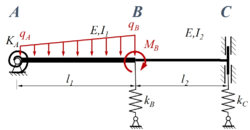
Gesucht ist die analytische Lösung für den Euler-Bernoulli-Balken. Im Vergleich zu Kw98 wird hier eine Lösung mit normierten Koordinaten verfolgt.
Ermitteln Sie für ein Euler-Bernoulli-Modell die analytischen Verläufe der Schnittgrößen und Verschiebungen im Balken für diese Parameter:
- .
Lösung mit Maxima
Die Aufgabe ist ein klassisches Randwertproblem:
- zwei Gebiete, in denen ein Euler-Bernoulli-Balken in AB und BC durch eine Streckenlast q belastet ist (in Bereich II ist die Streckenlast allerdings Null) und somit durch die Differentialbeziehungberschrieben wird.
- Rand- und Übergangsbedingungen in den Punkten A, B, C
Wir verwenden xi und ξi als Koordinaten je Bereich, in der Übersicht sieht das Randwertproblem so aus:
| Rand A | Bereich I | Übergang B | Bereich II | Rand C |
|---|---|---|---|---|
 | 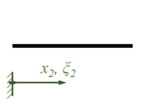 | |||
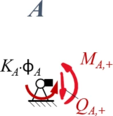 |  | 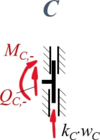
|
Header
Diese Aufgabe wird mit der Methode der Finiten Elemente in KW96 gelöst. Und im Vergleich zu KW98 wird hier die analytische Lösung mit dimensionslosen Koordinaten angeschreiben.
/*******************************************************/
/* MAXIMA script */
/* version: wxMaxima 15.08.2 */
/* author: Andreas Baumgart */
/* last updated: 2017-09-06 */
/* ref: TM-C, Labor 1 - dimensionslos */
/* description: die Auslenkung w und die unabhängige */
/* Ortskoordinate werden dim'los gemacht */
/*******************************************************/
Declarations
Wir definieren die Formfunktionen für die Streckenlast
- .
/* system parameter */
params: [EI[2]=EI[1]/2,
K[A]=EI[1]/l[1],
k[B]=0,
k[C] = EI[1]/l[1]^3,
q[B]=4*q[A],
l[2]=l[1]/2,
M[B] = 5*q[A]*l[1]^2];
/* form - functions */
phi[0](xi) := 1 - xi;
phi[1](xi) := xi;
Integration of Differential Equation to Formfunction
In Bereich I und II gilt dieselbe Bewegungs-Differentialgleichung
- ,
die wir durch Integration lösen und dann bereichsweise an Rand- und Übergangsbedingungen anpassen. Diese Aufgabe wird etwas übersichtlicher, wenn wir die Auslenkung w und die Ortskoordinate x dimensionslos machen. So wählen wir:
und setzten für die Bezugslänge die Auslenkung eines Kragbalkens unter konstanter Streckenlast (hier qA) an. Diese Auslenkung findet man in Standard-Lösungen unter "Kragbalken mit Streckenlast" zu:
Zusätzlich wählen wir zwei unabhängige, dimensionslose Ortskoordinaten für die Bereich I und II, die ihren Ursprung jeweils in den Punkten A und B haben.
Mit
ist die allgemeine Lösung für
... für Bereich I:
... für Bereich II:
- .
/* solve ....*/
dimless : l[Bez] = q[A]*l[1]^4/(8*EI[1]);
dgl : EI[i]*l[Bez]*diff(w(xi),xi,4)/l[i]^4 = q[0]*phi[0](xi) + q[1]*phi[1](xi);
dgl: subst(dimless,dgl);
/* generic solution */
displ : solve(integrate(integrate(integrate(integrate(dgl,xi),xi),xi),xi),w(xi));
sections: [[i=1, %c4=C[1,0], %c3=C[1,1], %c2=C[1,2], %c1=C[1,3], q[0]=q[A], q[1]=q[B]],
[i=2, %c4=C[2,0], %c3=C[2,1], %c2=C[2,2], %c1=C[2,3], q[0]= 0 , q[1]= 0 ]];
/* section I */
define( w[1](xi), ratsimp(subst(sections[1],subst(displ,l[Bez]*w(xi)))));
define(Phi[1](xi), diff(w[1](xi),xi )/l[1]^1);
define( M[1](xi), -EI[1]*diff(w[1](xi),xi,2)/l[1]^2);
define( Q[1](xi), -EI[1]*diff(w[1](xi),xi,3)/l[1]^3);
/* section II */
define( w[2](xi), ratsimp(subst(sections[2],subst(displ,l[Bez]*w(xi)))));
define(Phi[2](xi), diff(w[2](xi),xi )/l[2]^1);
define( M[2](xi), -EI[2]*diff(w[2](xi),xi,2)/l[2]^2);
define( Q[2](xi), -EI[2]*diff(w[2](xi),xi,3)/l[2]^3);
Boundary Conditions
Für die 2*4 = 8 Integrationskonstanten
suchen wir jetzt die passenden Gleichungen aus Rand- und Übergangsbedingungen.
Zur besseren Übersicht nennen wir die Schnitt-Momente und -Kräfte nach den jeweiligen Knotenpunkten A, B, C und fügen als Index ein + / - hinzu, um die Seite (+: rechts vom Knoten, -: links vom Knoten) zu kennzeichnen.
Aus Rand "A"
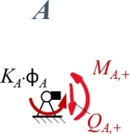
| Geometrische Randbedingungen
Kraft- und Momenten-Randbedingungen |
Aus Übergang "B"
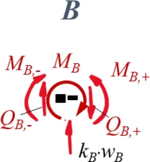
| Geometrische Randbedingungen
Kraft- und Momenten-Randbedingungen |
Aus Rand "C"
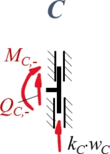
| Geometrische Randbedingungen
Kraft- und Momenten-Randbedingungen |
Und das liefert das Gleichungssystem aus 8 Gleichungen
für die Integrationskonstanten.
/* boundary conditions */
node[A]: [ w[1](0) = 0,
K[A]*Phi[1](0)+M[1](0) = 0];
node[B]: [ w[1](1) = w[2](0),
Phi[1](1) = Phi[2](0),
-Q[1](1) -k[B]*w[2](0) +Q[2](0) = 0,
-M[1](1) -M[B]+M[2](0) = 0];
node[C]: [ Phi[2](1) = 0,
-Q[2](1) - k[C]*w[2](1) = 0];
BCs : expand(subst(dimless,append(node[A],node[B],node[C])));
scale: [EI[1]/l[1]^4, 1/l[1]^2, EI[1]/l[1]^4, EI[1]/l[1]^3,1/l[1], 1/l[1]^2, EI[2]/l[1]^3, 1/l[1]];
BCs : expand(scale*BCs);
Prepare for Solver
Das Gleichungssystem wollen wir als
schreiben, also - hier nach Einsetzen der System-Parameter
/* integration constants = unknowns */
ICs : [C[1,0],C[1,1],C[1,2],C[1,3],C[2,0],C[2,1],C[2,2],C[2,3]];
ACM: augcoefmatrix(BCs,ICs);
/* system matrix and rhs */
AA : submatrix(ACM,9);
bb : - col(ACM,9);
/* print OLE */
print(subst(params,AA),"*",x,"=",subst(params,bb));
Solving
Das Lösen des Gleichungssystems liefert
/* solving */
D : ratsimp(determinant(AA))$
[ P, L, U] : ratsimp(get_lu_factors(lu_factor(AA)))$
cc : ratsimp(linsolve_by_lu(AA,bb)[1])$
sol : makelist(ICs[i] = cc[i][1],i,1,8)$
Post-Processing
Und die Ergebnisse können wir uns anschauen ...
... für w(x):
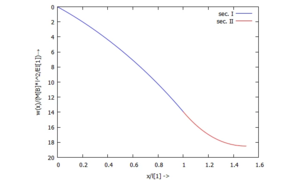
... für Φ(x):
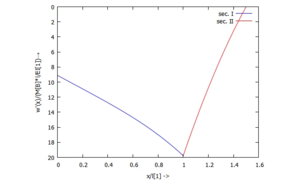
... für M(x):
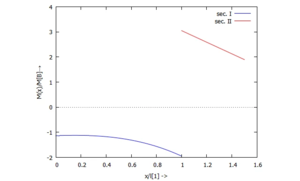
... für Q(x):
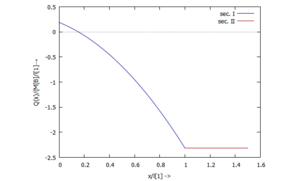
... für die Lager-Reaktionskräfte:
/* bearing forces and moments */
reactForces: [A[z] = Q[1](0),
M[A] = K[A]*Phi[1](0),
B[z] = k[B]*w[2](0),
C[z] = k[C]*w[2](1),
M[C] = M[2](1)];
expand(subst(dimless,subst(params,subst(sol, reactForces))));
/* plot displacements */
fcts: [[ w [1](xi), w [2](xi)],
[Phi[1](xi),Phi[2](xi)],
[ M [1](xi), M [2](xi)],
[ Q [1](xi), Q [2](xi)]];
facts: [1/l[Bez], l[1]/l[Bez], 1/(q[A]*l[1]^2), 1/(q[A]*l[1])];
textlabels : ["w(x)/(M[B]*l^2/EI[1])→", "w'(x)/(M[B]*l/EI[1])→", "M(x)/M[B]→", "Q(x)/(M[B]/l[1]→"];
for i: 1 thru 4 do(
f : expand(subst(dimless,subst(params,facts[i]*[subst(sol, fcts[i][1]),
subst(sol, fcts[i][2])]))),
r : subst(params,l[2]/l[1]),
preamble: if i<=2 then "set yrange [] reverse" else "set yrange []",
plot2d([[parametric, t, subst(t,xi,f[1]), [t,0,1]],
[parametric, 1+r*t, subst(t,xi,f[2]), [t,0,1]]],
[legend, "sec. I", "sec. II"],
[gnuplot_preamble, preamble],
[xlabel, "x/l[1] ->"],
[ylabel, textlabels[i]]))$
Links
- ...
Literature
- ...